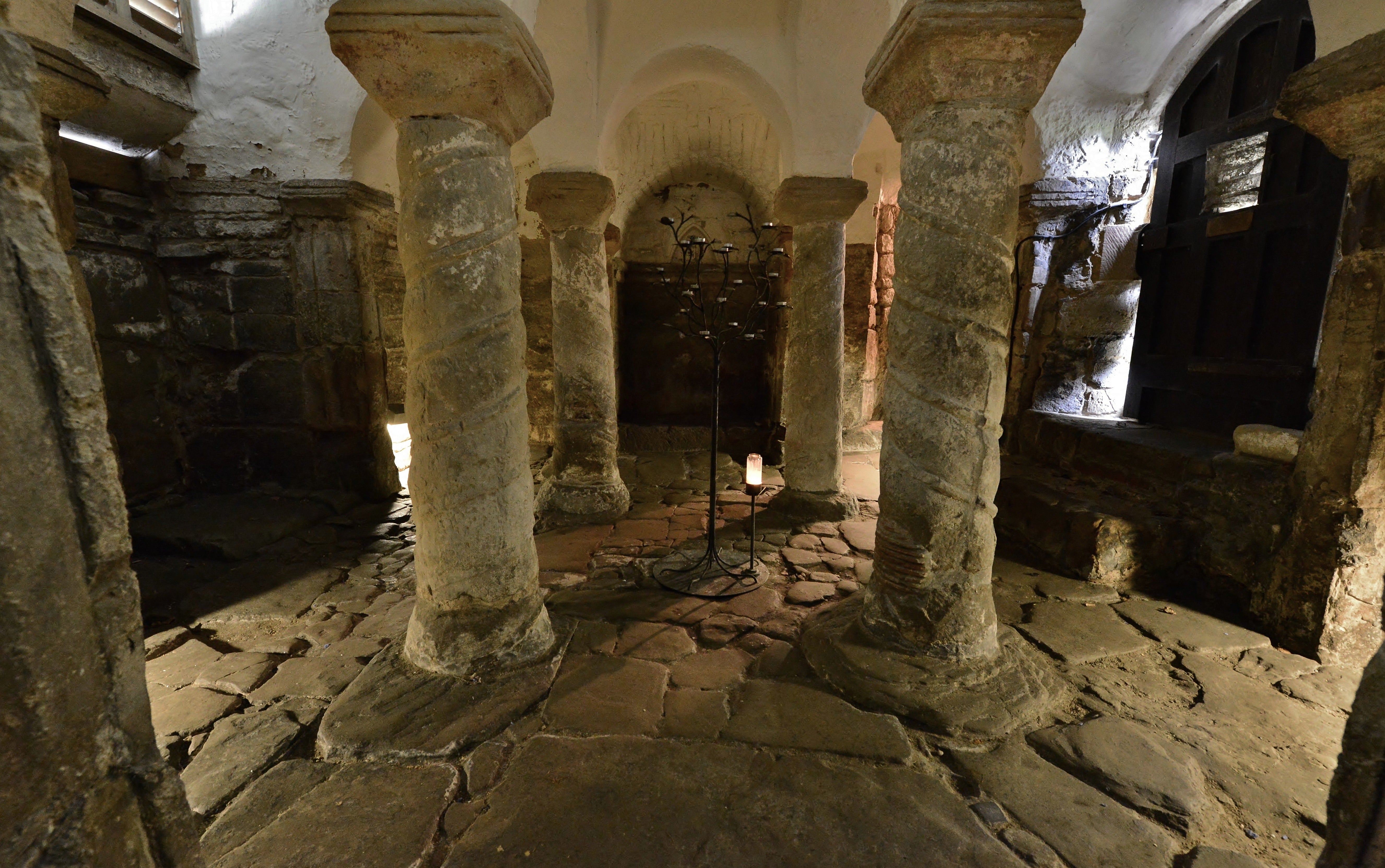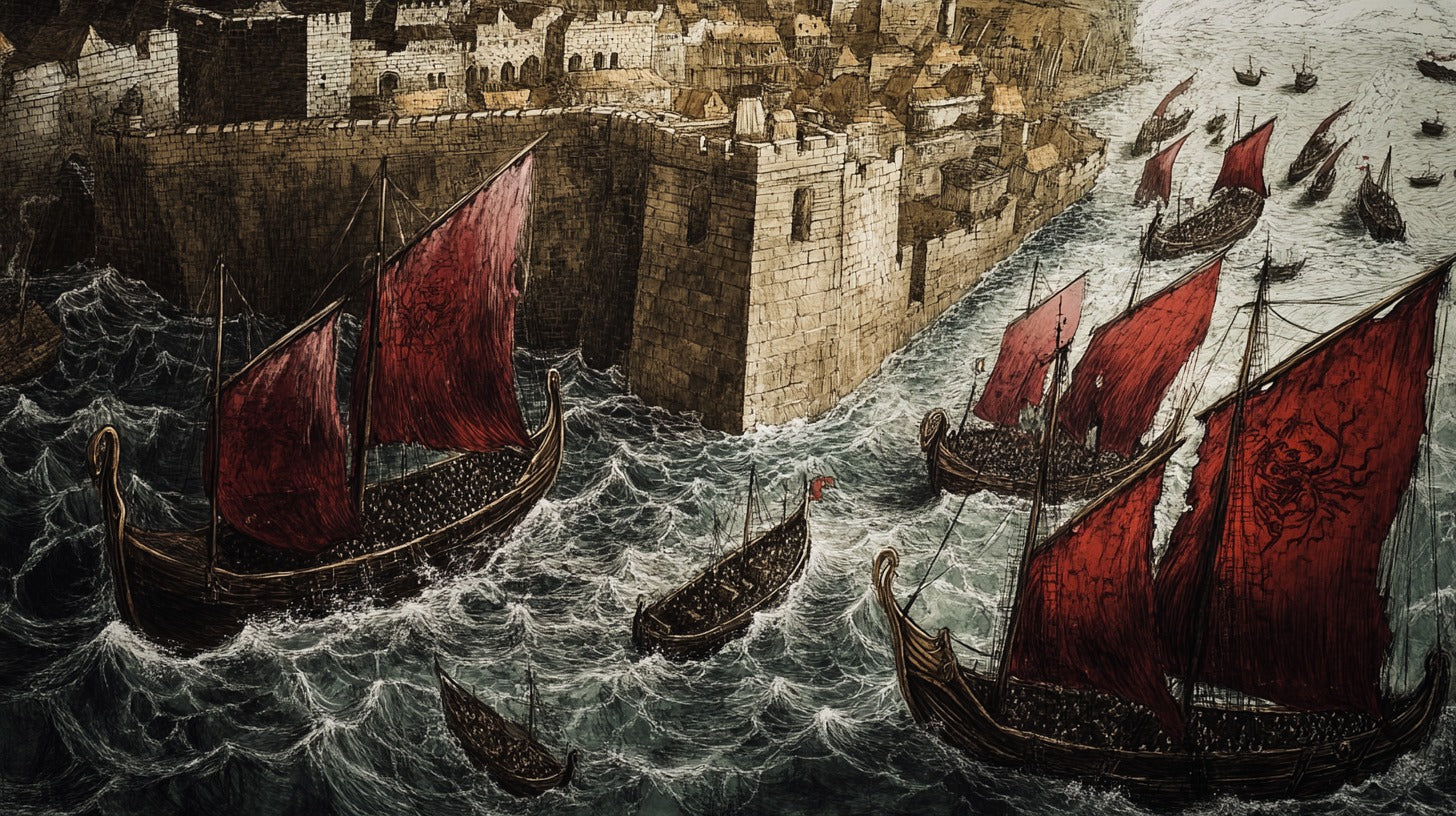
Viking Warriors Repurpose Anglo-Saxon Holy Site at Repton
The Viking presence at St. Wystan's Church in Repton, Derbyshire, particularly in its crypts, represents a fascinating intersection of Anglo-Saxon religious architecture and Viking military strategy. This article explores the historical context, archaeological evidence, and significance of the Viking occupation of this sacred site during their campaigns in England in the late 9th century.
Historical Context
The late 8th and 9th centuries saw an increase in Viking raids and eventual invasions of England. These Scandinavian warriors, primarily from Denmark and Norway, initially conducted hit-and-run coastal raids but gradually began to establish more permanent settlements and launch larger-scale invasions.
Repton's Significance in Anglo-Saxon England
Repton held considerable importance in the Anglo-Saxon kingdom of Mercia. It served as a royal and ecclesiastical center, housing a monastery and the mausoleum of several Mercian kings. The presence of St. Wystan's Church, with its distinctive crypt, underscored Repton's status as a site of both political and religious significance.
St. Wystan's Church at Repton

Top side view of St Wystan's Church (Photo: Djharrisx CC BY-NC 2.0)
History and Architecture
St. Wystan's Church, dedicated to the Anglo-Saxon prince and martyr Wystan (also known as Wigstan), was constructed in the 8th century. The church is renowned for its Anglo-Saxon architecture, particularly its crypt, which dates to around 750 AD. The crypt's design, with its barrel-vaulted ceiling and replica of Christ's tomb in Jerusalem, reflects the sophisticated craftsmanship of the period.
The Crypt and Its Original Purpose
Originally, the crypt served as a mausoleum for Mercian royalty. It housed the remains of King Æthelbald of Mercia (died 757) and later, those of St. Wystan himself (died 849). The crypt's layout and decorative elements were designed to create a sacred space for prayer and veneration of these important figures in Mercian history.
Viking Occupation of Repton

Viking Age sword (Scandinavian of origin) discovered in Repton, Mercia (Photo: Roger from Derby CC BY 3.0).
Timeline of Events
In 873-874 AD, the Great Heathen Army, a coalition of Viking forces, arrived at Repton. Led by the sons of Ragnar Lothbrok, including Ivar the Boneless, Ubbe and Halfdan, this army had been campaigning in England since 865. Their arrival at Repton marked a significant moment in their strategy to conquer and control Mercia.
Archaeological Evidence
Extensive archaeological excavations conducted at Repton, particularly during the 1970s and 1980s by Martin Biddle and Birthe Kjølbye-Biddle, have provided substantial evidence of the Viking presence. These excavations uncovered a massive D-shaped earthwork enclosure, typical of Viking defensive structures, incorporating the church at its highest point.
The Viking Use of St. Wystan's Crypt

View of some of the steps located within the crypt (Photo: Robinbyles CC BY-NC 2.0).
Repurposing of the Sacred Space
The Vikings' use of St. Wystan's crypt represents a dramatic repurposing of sacred space. Archaeological evidence suggests that the crypt was used as a burial chamber for high-ranking members of the Great Heathen Army. This appropriation of a Christian holy site for pagan burials underscores the cultural and religious upheaval brought about by the Viking invasion.
Archaeological Findings in the Crypt
Excavations in and around the crypt have yielded significant findings. Outside the crypt, archaeologists discovered a charnel deposit containing the disarticulated remains of at least 264 individuals. Radiocarbon dating places these remains in the period of Viking occupation. Within the crypt itself, evidence of a prominent Viking burial was found. This included the remains of a man aged 35-45, accompanied by items such as a Thor's hammer pendant and a boar's tusk, suggesting his high status and pagan beliefs. Various artifacts associated with Viking culture were found in and around the burial sites, including weapons, jewelry, and coins.
Significance of the Viking Presence

Anglo Saxon Barely twist colums in the St Wystan's Church crypt (Photo: Robinbyles CC BY-NC 2.0).
Impact on Local Anglo-Saxon Population
The Viking occupation of Repton, and particularly their use of St. Wystan's crypt, would have had a profound impact on the local Anglo-Saxon population. The desecration of a royal mausoleum and Christian holy site (not unlike the Raid on Lindisfarne) likely served as a powerful symbol of Viking dominance and the supplanting of Anglo-Saxon authority in the region.
Strategic Importance for Viking Campaigns
Repton's location on the banks of the River Trent made it a strategically valuable site for the Vikings. Control of Repton allowed them to establish a defensible winter camp, launch further raids into Mercia and neighboring kingdoms, and assert their dominance over a significant religious and political center.
Legacy and Modern Interpretations
The Viking presence at St. Wystan's Church has left an indelible mark on the site's history and continues to fascinate historians and archaeologists. Modern interpretations of the evidence have led to ongoing debates about the nature of Viking-Anglo-Saxon interactions, the role of religious sites in military strategies, and the process of cultural and religious change in early medieval England.
Recent technological advancements, such as isotope analysis and DNA testing, have provided new insights into the origins and lifestyles of both the Viking occupiers and the local population. These scientific methods have allowed researchers to gain a more nuanced understanding of the demographic makeup of the Viking forces and their interactions with the local Anglo-Saxon population.
The study of the Viking presence at St. Wystan's Church has also contributed to broader discussions about the nature of cultural exchange and assimilation during periods of conquest. The repurposing of the crypt demonstrates how invading forces could appropriate and reinterpret local symbols of power and religion to establish their own authority.
Furthermore, the archaeological evidence from Repton has played a crucial role in reassessing the traditional narratives of Viking invasions. It has provided tangible proof of the scale and organization of Viking military operations, challenging earlier perceptions of Vikings as merely opportunistic raiders.
Conclusion
The Viking presence at St. Wystan's Church in Repton, particularly their use of the crypt, represents a pivotal moment in English history. It exemplifies the complex interplay between invaders and locals, paganism and Christianity, and military strategy and sacred spaces. The archaeological evidence from Repton has significantly enhanced our understanding of the Viking invasions and their impact on Anglo-Saxon England.
The repurposing of St. Wystan's crypt serves as a powerful symbol of the cultural and religious transformations occurring during this tumultuous period. It illustrates how sacred spaces could be reinterpreted and used to assert dominance in conquered territories. The findings at Repton have not only shed light on the specific events of the Viking occupation but have also contributed to our broader understanding of the processes of invasion, settlement, and cultural exchange in medieval Europe.
As research continues, this site remains a crucial window into a period that shaped the course of English history. The ongoing study of the Viking presence at St. Wystan's Church continues to yield new insights, challenging and refining our understanding of this critical juncture in the formation of medieval England.
FAQs
- When did the Vikings occupy Repton?
The Vikings, specifically the Great Heathen Army, occupied Repton in 873-874 AD.
- What evidence is there of Viking presence in St. Wystan's crypt?
Archaeological excavations have revealed a high-status Viking burial within the crypt, along with associated grave goods and a mass burial outside.
- Why was Repton significant to both Anglo-Saxons and Vikings?
Repton was a royal and religious center for the Anglo-Saxon kingdom of Mercia, while for the Vikings, it served as a strategic winter camp and symbol of their conquest.
- What happened to the original Anglo-Saxon burials in the crypt?
While some Anglo-Saxon remains were displaced, the exact fate of all original burials is not entirely clear from the archaeological record.
- How has the discovery of Viking presence at Repton impacted our understanding of this period?
It has provided crucial insights into Viking invasion strategies, their interaction with local populations, and the repurposing of sacred spaces during conquest.
References
Max Adams (2017) Alfred's Britain: War And Peace In The Viking Age
"Anglo-Saxon Crypt (8th Century) under Saint Wystans Church, Repton, Derbyshire" by The Roaming Picture Taker is licensed under CC BY 2.0.
"St Wystan's Church, Repton" by djharrisx is licensed under CC BY-NC 2.0.
"Repton, St. Wystan's Church, The early c8th Anglo Saxon crypt - geograph.org.uk - 4949391" by Michael Garlick is licensed under CC BY-SA 2.0.
"Crypt steps in St Wystan's church, Retford" by robinbyles is licensed under CC BY-NC 2.0.








